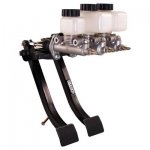Now where have I heard that before?

I said this about a Hydro boost system, not Hydromax.. Both hydraulically assisted hydraulic systems, but one in the 10K ish gvw range, the other in the 26K gvw range, and much, much higher if you go back a few years (with wrecking yard parts). We're talking about bicycle brakes bolted onto a Harley Davidson here...
While working, there should be no difference between a single circuit and a 3x3 dual circuit. It's only in the unlikely event of a problem that the asymmetry would surface.
This I will definitely agree with. The axle that is split will not care which circuit the pressure comes from, so long as the pressures are equal. And as much as I am hashing this whole thing out, I am not disagreeing in any way that any available braking after a catastrophic component failure is better than none at all.
But I repeat, I'll take 50% asymmetrical braking above 0% symmetrical braking in an emergency.
This is the part that I'm having a really hard time with... You say this as if there are only two options. I don't see what is wrong with wrong with 50 percent symmetrical braking?
I also have some additional food for thought on the proportioning issue. And this is FOOD FOR THOUGHT, as this stretches beyond my daily experience with the above braking systems... It will also obviously be for a 6X6 configuration only...
Anyway, there WAS a dual outlet master cylinder installed to the late model air force deuces, and it was also used on the A3 ESP program, so what did they do? Turns out, the answer is not so clear. In the NOMENCLATURE (the name assigned to the part) there is discrepancy depending on where you look the part up. But there is a "valve" between the two outlet lines. Somp places it's listed as a differential valve, and some as a differential and proportioning valve... So, what is it really?
On the old site in the TM section, third page, second from the top is
SMARPI 9-2320-209-14&P which is the supplemental manual for A2 varieties with the split brake system. On page F13 of the document (page 66 of the PDF) there is a picture of the master cylinder and illustration number 8 shows the valve.
This valve IS a differential valve, because it does run the light on the dash... In that manual it is called a "differential valve", but as I said, other places (including the 386 TM for the A3) list it as a "differential and proportioning valve". So what is it? I don't have one, however looking at this picture (or the picture in the 386 TM shows several drawings of the part. The pressure differential valve (and the associated switch) is clearly there, but I see no other valving. I also see diagnostic steps to diagnose a failed differential valve, but none to diagnose a failed proportioning valve. (which even in the same "block" will remain separate valves with separate functions). The "proportioning" part which acts on a single line is clearly missing from the TM. There is no law saying that they all look exactly alike, but here's another Howstuffworks illustration showing what I mean and identifying aproximately what a proportioning valve (or proportioning section of a combination valve) would look like.
It could be somehwhat different, but somewhere on that block there has to be a place with another valve screwed into it plumbed (internally) so as to act on one line but not the other.
HowStuffWorks "How Master Cylinders and Combination Valves Work"
If someone had a real live one it'd be a lot more conclusive, as to what a much more "modern" engineering standard has deemed appropriate as far as biasing the brakes. Based on what I've listed, I'm leaning toward it being an unbiased system, however it may be that this is not the case. FWIW, they did split the brake with the front axle as one circuit and the rear axle as a second circuit, but they had two airpacks to do it, each with a full 100 percent system capacity, so either is easily capable of running all six brakes at once. Again, no "real" conclusion there either...
Anyhow, as you can probably tell I am very intrigued with the idea of retrofitting this system. (I dunno why, I have lots bigger fish to fry right now...) and when the time comes that you do this, I would love to know the outcome, as well as installation photos. As I said earlier, it's not the performance, but the mounting requirements (and my requirements not to alter the pedals and the appearance of the trucck) that have prevented me from doing this thus far.



